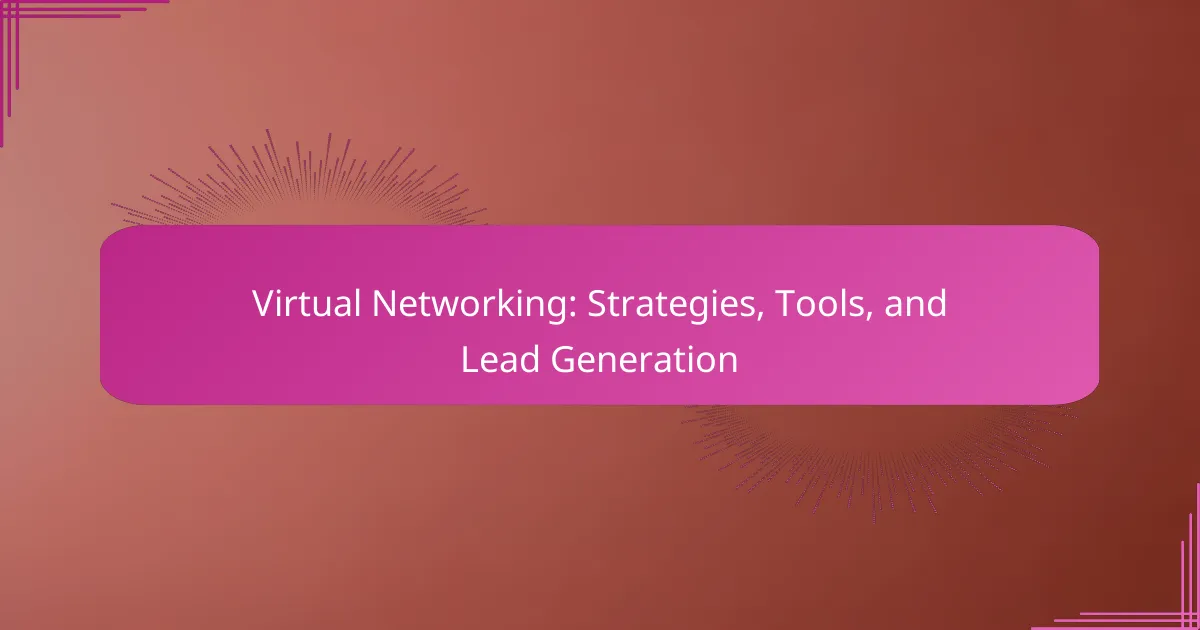In today’s digital landscape, effective virtual networking is essential for building relationships and expanding your professional presence. By utilizing various platforms and tools, you can connect with industry peers, generate valuable leads, and enhance your personal brand. Embracing these strategies not only streamlines communication but also opens doors to new opportunities in your field.

What are effective virtual networking strategies?
Effective virtual networking strategies focus on building relationships and expanding your professional presence online. By leveraging various platforms and tools, you can connect with industry peers, generate leads, and enhance your personal brand.
Personal branding on LinkedIn
Personal branding on LinkedIn involves optimizing your profile to showcase your skills, experiences, and achievements. Ensure your profile picture is professional, your headline is clear, and your summary highlights your unique value proposition.
Regularly share relevant content and engage with others’ posts to increase visibility. Aim for a consistent posting schedule, such as weekly, to maintain engagement with your network.
Utilizing virtual events
Utilizing virtual events, such as webinars and online conferences, can significantly enhance your networking efforts. Attend events relevant to your industry and actively participate in discussions to connect with speakers and attendees.
Consider hosting your own virtual event to establish authority in your field. Promote it through your social media channels and encourage attendees to share their experiences, expanding your reach.
Engaging in online communities
Engaging in online communities, such as forums and social media groups, allows for meaningful interactions with like-minded professionals. Choose platforms that align with your industry, such as Reddit for tech or Facebook groups for creative fields.
Contribute valuable insights and answer questions to build credibility. Aim to connect with individuals who share similar interests, which can lead to potential collaborations or referrals.
Leveraging social media platforms
Leveraging social media platforms like Twitter and Instagram can broaden your networking reach. Use these platforms to share industry news, insights, and personal achievements to attract followers and engage with your audience.
Utilize hashtags relevant to your field to increase discoverability. Follow industry leaders and engage with their content to foster connections that may lead to opportunities.
Building a referral network
Building a referral network involves cultivating relationships with professionals who can recommend your services. Start by connecting with former colleagues, clients, and industry contacts who understand your work ethic and expertise.
Consider implementing a referral program that incentivizes others to refer clients to you. Regularly check in with your network to maintain relationships and keep your services top of mind.

Which tools enhance virtual networking?
Several tools significantly enhance virtual networking by facilitating communication, collaboration, and connection-building. The right tools can streamline interactions and help you effectively engage with your network, whether for professional growth or lead generation.
Zoom for video conferencing
Zoom is a leading platform for video conferencing, allowing users to host virtual meetings, webinars, and conferences. Its user-friendly interface and reliable performance make it ideal for networking events where face-to-face interaction is crucial.
When using Zoom, consider scheduling meetings in advance and sending calendar invites to ensure attendance. Utilize features like breakout rooms for smaller group discussions, which can foster deeper connections among participants.
Slack for team communication
Slack is a powerful tool for team communication, enabling real-time messaging, file sharing, and collaboration. It allows users to create channels for specific topics, making it easier to engage with colleagues and network within your industry.
To maximize Slack’s potential, actively participate in relevant channels and share valuable insights. Avoid overwhelming your team with messages; instead, focus on quality interactions that can lead to meaningful connections.
LinkedIn for professional connections
LinkedIn is the premier social network for professionals, designed to connect individuals and businesses. It offers features like profile creation, networking opportunities, and content sharing, making it essential for building a professional presence online.
To effectively use LinkedIn, regularly update your profile and engage with your connections by commenting on their posts or sharing industry-related articles. Joining relevant groups can also expand your network and provide opportunities for collaboration.
Meetup for event organization
Meetup is a platform that facilitates the organization of events and gatherings based on shared interests. It allows users to create groups and schedule events, making it easier to connect with like-minded individuals in your area or field.
When organizing events on Meetup, ensure clear communication about the event’s purpose and agenda. Encourage attendees to introduce themselves and share their goals to foster networking opportunities during the event.

How can virtual networking generate leads?
Virtual networking can effectively generate leads by connecting businesses with potential clients through online platforms and events. By leveraging digital tools and strategies, organizations can reach a broader audience and engage with prospects in meaningful ways.
Targeted outreach campaigns
Targeted outreach campaigns focus on identifying specific groups of potential leads and engaging them directly. This can involve using social media platforms like LinkedIn to connect with industry professionals or sending personalized emails to prospects who fit your ideal customer profile.
To maximize effectiveness, segment your audience based on criteria such as industry, location, or interests. This allows for tailored messaging that resonates with each group, increasing the chances of conversion.
Content marketing strategies
Content marketing strategies involve creating valuable, relevant content that attracts and engages your target audience. This can include blog posts, webinars, or informative videos that address the needs and pain points of potential leads.
Consider using SEO techniques to optimize your content for search engines, making it easier for prospects to find you. Regularly sharing insights or case studies can position your brand as a thought leader, fostering trust and encouraging leads to reach out.
Follow-up techniques
Effective follow-up techniques are crucial for converting leads generated through virtual networking. After initial contact, send a personalized message thanking them for their time and reiterating your value proposition.
Utilize tools like CRM systems to track interactions and schedule follow-ups. Aim for a balance between persistence and patience; a follow-up within a week is often effective, but avoid overwhelming prospects with too many messages.

What are the prerequisites for successful virtual networking?
Successful virtual networking requires a clear understanding of your objectives and the audience you want to connect with. Establishing these prerequisites helps create meaningful interactions and fosters valuable relationships in a digital environment.
Understanding your target audience
To effectively network, you must identify who your target audience is. This includes understanding their interests, needs, and pain points. Consider factors such as industry, job roles, and demographics to tailor your approach.
Researching your audience can involve analyzing social media profiles, engaging in relevant online communities, or reviewing industry reports. This insight allows you to craft personalized messages that resonate with potential connections.
Setting clear networking goals
Establishing clear networking goals is essential for guiding your interactions. Determine what you hope to achieve, whether it’s generating leads, finding mentors, or exploring collaboration opportunities. Specific goals can help you stay focused during networking events.
Consider using the SMART criteria—Specific, Measurable, Achievable, Relevant, and Time-bound—to structure your goals. For example, aim to connect with five industry professionals within a month or schedule three informational interviews each week. This clarity will enhance your networking effectiveness.

How to choose the right virtual networking platform?
Choosing the right virtual networking platform involves assessing your specific needs, such as user experience, integration with existing tools, and budget. A well-suited platform can enhance engagement and streamline your networking efforts.
Assessing user interface and experience
The user interface (UI) and overall experience are critical when selecting a virtual networking platform. Look for intuitive navigation, clear layouts, and accessibility features that cater to all users. A platform with a user-friendly design can significantly improve participant engagement.
Consider testing the platform through demos or trial versions to gauge how easily users can join events, interact with others, and access features. Pay attention to feedback from potential users to ensure the platform meets their expectations.
Evaluating integration capabilities
Integration capabilities are essential for a seamless virtual networking experience. Ensure the platform can connect with your existing tools, such as CRM systems, email marketing software, and social media channels. This integration allows for efficient data sharing and a more cohesive networking strategy.
Check if the platform supports APIs or third-party integrations to enhance functionality. A platform that easily integrates with your current systems can save time and reduce manual data entry, making your networking efforts more effective.
Considering pricing models
Pricing models vary widely among virtual networking platforms, so it’s important to understand what fits your budget. Some platforms offer tiered pricing based on features, while others may charge per event or user. Assess your networking frequency and scale to choose a model that aligns with your financial resources.
Look for platforms that provide transparent pricing and consider any hidden costs, such as transaction fees or additional charges for premium features. Many platforms offer free trials or demos, allowing you to evaluate their value before committing financially.

What are the best practices for virtual networking etiquette?
Effective virtual networking etiquette involves being respectful, professional, and engaging. Key practices include timely communication, active listening, and maintaining a professional demeanor throughout interactions.
Be respectful of others’ time
When engaging in virtual networking, always be mindful of the time you take during meetings or discussions. Schedule calls with clear agendas and stick to the allotted time to show respect for others’ schedules. Aim to keep conversations concise and focused.
Maintain professionalism
Professionalism is crucial in virtual networking. Dress appropriately for video calls and ensure your background is tidy and free from distractions. Use clear and polite language, and avoid informal slang unless you know the other party well.
Engage actively
Active engagement is vital for effective networking. Make eye contact by looking at the camera, nodding to show understanding, and asking relevant questions. This demonstrates your interest and helps build rapport with your networking contacts.
Follow up after meetings
After a virtual networking session, always follow up with a thank-you message or email. This reinforces your interest and helps maintain the relationship. A brief note expressing appreciation for their time and insights can go a long way in solidifying connections.
Utilize appropriate tools
Choosing the right tools can enhance your virtual networking experience. Platforms like Zoom, Microsoft Teams, and LinkedIn are popular for professional interactions. Familiarize yourself with these tools to ensure smooth communication and effective engagement.
